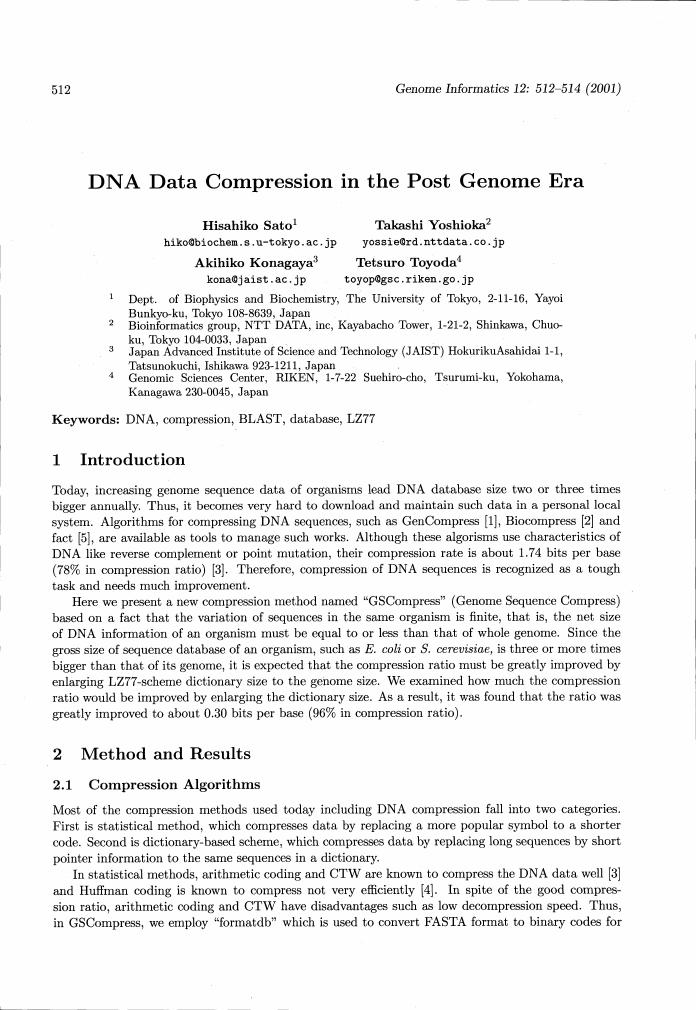- 著者
- MASAHITO OHUE YURI MATSUZAKI YUTAKA AKIYAMA
- 出版者
- Japanese Society for Bioinformatics
- 雑誌
- Genome Informatics (ISSN:09199454)
- 巻号頁・発行日
- vol.25, no.1, pp.25-39, 2011 (Released:2011-08-03)
- 参考文献数
- 22
Elucidating protein-RNA interactions (PRIs) is important for understanding many cellular systems. We developed a PRI prediction method by using a rigid-body protein-RNA docking calculation with tertiary structure data. We evaluated this method by using 78 protein-RNA complex structures from the Protein Data Bank. We predicted the interactions for pairs in 78×78 combinations. Of these, 78 original complexes were defined as positive pairs, and the other 6,006 complexes were defined as negative pairs; then an F-measure value of 0.465 was obtained with our prediction system.
2 0 0 0 OA DNA Data Compression in the Post Genome Era
- 著者
- Hisahiko Sato Takashi Yoshioka Akihiko Konagaya Tetsuro Toyoda
- 出版者
- Japanese Society for Bioinformatics
- 雑誌
- Genome Informatics (ISSN:09199454)
- 巻号頁・発行日
- vol.12, pp.512-514, 2001 (Released:2011-07-11)
- 参考文献数
- 5
- 著者
- 伊奈 康夫 五條堀 孝
- 出版者
- Japanese Society for Bioinformatics
- 雑誌
- Genome Informatics (ISSN:09199454)
- 巻号頁・発行日
- vol.2, pp.74-77, 1991
- 著者
- Hirotugu Akaike
- 出版者
- Japanese Society for Bioinformatics
- 雑誌
- Genome Informatics (ISSN:09199454)
- 巻号頁・発行日
- vol.14, pp.263-265, 2003 (Released:2011-07-11)
- 参考文献数
- 4
The role of a model is to provide adequate knowledge to handle a particular problem. The work of modeling starts on the basis of the feel and knowledge of the object and proceeds by developing guesses about the structure of the object. In this paper characteristics of this process are demonstrated with the example of the analysis of the golf swing motion.
1 0 0 0 OA Extraction of Organism Groups from Phylogenetic Profiles Using Independent Component Analysis
- 著者
- Yoshihiro Yamanishi Masumi Itoh Minoru Kanehisa
- 出版者
- Japanese Society for Bioinformatics
- 雑誌
- Genome Informatics (ISSN:09199454)
- 巻号頁・発行日
- vol.13, pp.61-70, 2002 (Released:2011-07-11)
- 参考文献数
- 12
In recent years, the analysis of orthologous genes based on phylogenetic profiles has received popularity in bioinfomatics. We propose a new method to extract organism groups and their hierarchy from phylogenetic profiles using the independent component analysis (ICA). The method involves first finding independent axes in the projected space from the multivariate data matrix representing phylogenetic profiles for a number of orthologous genes. Then the extracted axes are correlated with major organism groups, according to the extent of affiliaion of axes scores for all the genes to specific organisms. The ICA was applied to the phylogenetic profiles created for 2875 orthologs in 77 organisms by using the KEGG/GENES database. The 9 extracted components out of 18 predefined components well represented the organism groups as categorized in KEGG. Furthermore, we performed the cluster analysis and obtained the hierarchy of organism groups.
1 0 0 0 OA The Sequence Attribute Method for Determining Relationships Between Sequence and Protein Disorder
- 著者
- Qian Xie Zoran Obradovic Gregory E. Arnold Ethan Garner Pedro Romero A.Keith Dunker
- 出版者
- Japanese Society for Bioinformatics
- 雑誌
- Genome Informatics (ISSN:09199454)
- 巻号頁・発行日
- vol.9, pp.193-200, 1998 (Released:2011-07-11)
- 参考文献数
- 22
The conditional probability, P (s|x), is a statement of the probability that the event, s, will occur given prior knowledge for the value of x. If x is given and if s is randomly distributed, then an empirical approximation of the true conditional probability can be computed by the application of Bayes' Theorem. Here s represents one of two structural classes, either ordered, so, or disordered, sd, and x represents an attribute value calculated over a window of 21 amino-acids. Plots of P (slx) versus x provide information about the correlation between the given sequence attribute and disorder or order. These conditional probability plots allow quantitative comparisons between individual attributes for their ability to discriminate between order and disorder states. Using such quantitative comparisons, 38 different sequence attributes have been rank-ordered. Attributes based on cysteine, the aromatics, flexible tendencies, and charge were found to be the best attributes for distinguishing order and disorder among those tested so far.
- 著者
- GÜRLER AYSAM KNAPP ERNST-WALTER
- 出版者
- Japanese Society for Bioinformatics
- 雑誌
- Genome Informatics (ISSN:09199454)
- 巻号頁・発行日
- vol.18, pp.183-191, 2007
We evaluate the performance of common substitution matrices with respect to structural similarities. For this purpose, we apply an all-versus-all pairwise sequence alignment on the ASTRAL40 [7] dataset, consisting of 7290 entries with a pairwise sequence identity of at most 40%. Afterwards, we compare the 100 highest scoring sequence alignments to their corresponding structural alignments, which we obtain from our structure alignment database. Our database consists of about 18.6 million pairwise entries. We calculated these alignments by applying the current version of GANGSTA [1], our non-sequential structural alignment tool, on about 26 million pairs. The results illustrate the difficulty of homology based protein structure prediction in cases of low sequence similarity. Further, the large fraction of structurally similar proteins in the ASTRAL40 dataset is quantitatively measured. Thereby, this investigation yields a new perspective on the topic of sequence and structure relation. Hence, our finding is a large-scale quality measure for any sequence based method, which aims to detect structural similarities.
